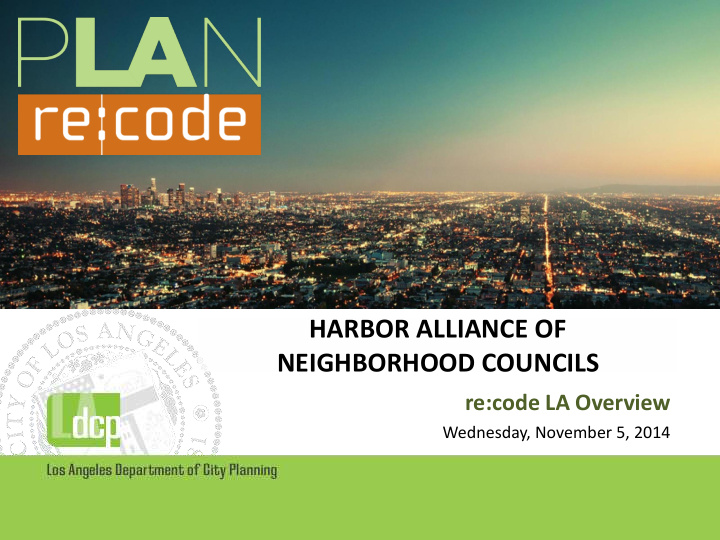



HARBOR ALLIANCE OF NEIGHBORHOOD COUNCILS re:code LA Overview Wednesday, November 5, 2014
History & Background Last comprehensive revision to Zoning Code was in 1946 Consolidated 11 separate Zoning Ordinances into 1
History & Background Grown from 84 small-format pages to over 600 standard-format pages
Current Problems Same basic set of Zoning Classifications maintained since Post-War Era Scattered language results in vague, contradicting, and unnecessarily complicated regulations Relies heavily on Entitlements, Site-Specific Conditions, and Overlays Does not always promote good urban design
Overlays & Site-Specific Conditions 60% of the City is covered by special overlays, and site- specific conditions (Qs, Ts, & Ds) shown in dark brown on the left Majority of properties have 2 or more different sets of regulations
Code Interpretations & Memos Thousands of Zoning Code Interpretations and Memos
General Plan Framework 1990’s, City adopted the General Plan Framework Element Strategy to accommodate growth and development Zoning Code never revised to implement these policies and standards
Five-Year Work Program, 18 months in: – Dynamic Web-Based Zoning Code – Guides to Zoning – Unified Downtown Development Code Project Team made up of City Employees and Planning, Environmental, & Web Consultants Image Source: SRTM Team NASA/JPL/NIMA
Project Consultants Code Studio John Kaliski Architects Lead Consultant Architecture White & Smith, LLC Patricia Smith , Landscape Architect Legal/Drafting Support Landscape Architecture Torti Gallas and Partners HR&A Advisors Urban Design/Planning Economic Impact Winter & Company The Robert Group Historic Preservation/Urban Design Community Outreach Peter Park VPE Public Relations Process/Administration Analysis Community Outreach Lamphier - Gregory The Doyle Logan Company Planning/Environmental Analysis Project Identity Urban Insight Design Gnomes Web Design/Web-Based Code Graphic Design/Editing Impact Sciences Environmental Impact Assessment
Visual & Streamlined Code Easy to read & user-friendly format Image Source: Code Studio
More Effective Community Planning Tools Image Source: Code Studio
Web-Based Zoning Code System Web-based Code delivery system Extensive use of graphics, tables & charts Intuitive Interaction - compile the most relevant provisions for a particular property Develop a “digital concierge” or TurboTax™ -type system Image Sources: Code Studio
Predictable & Effective Processes
Predictable & Effective Processes Image Source: Code Studio
Downtown Revitalization Ensure that Downtown Los Angeles is poised to take advantage of ongoing economic recovery Ready to absorb larger share of citywide density Maximize transportation infrastructure investment in Downtown
Public Participation Zoning Advisory Committee Regional Forums Virtual Forums Stakeholder Group Meetings Project Website Other Methods Electronic Mailing List, Social Networks, etc. Image Source: Picassa
Where We Are June 2012 - Council Approved Funding June 2013 - Project Officially Launched November 2013 – ZAC Formed March 2014 – Code Evaluation Report Released May/June 2014 – Evaluation Report to CPC Summer 2014 – PLUM and City Council December 2014 – Code Approach Report January 2015 - Drafting Downtown Code
Visit Our Website at: recode.la
Recommend
More recommend